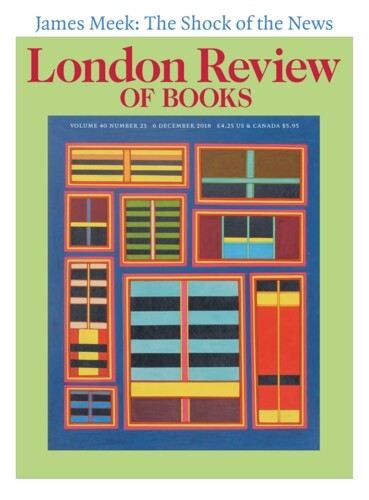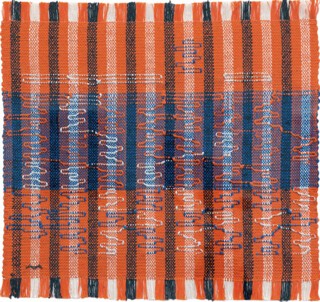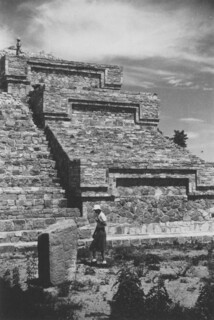Anni Albers joined the Bauhaus in 1922, four years after the end of the First World War. ‘Outside was the world I came from, a tangle of hopelessness, of undirected energy, of cross-purposes. Inside, here, at the Bauhaus after some two years of its existence, was confusion, too, I thought, but certainly no hopelessness or aimlessness, rather exuberance with its own kind of confusion.’ At first, she was sceptical of the weaving workshop, one of the specialised workshops students were required to enter after completing the general foundation course. It had become known as the Women’s Workshop. ‘To work with threads seemed sissy to me,’ she wrote, looking back in 1982, at the age of 83. ‘I wanted something to be conquered. But circumstances held me to threads and they won me over. I learned to listen to them and to speak their language.’ She made the language of threads, and the process of weaving, the foundation of a philosophy, and a visionary politics. Weaving seemed to her a means of re-rooting humanity after the war, connecting the present to the very deep past. This conviction took Albers and her handloom on what Briony Fer, co-curator of Tate Modern’s Albers retrospective (until 27 January), calls one of ‘modernism’s migrations’, from Weimar to Dessau, then to the experimental Black Mountain College in North Carolina, and finally to New Haven and Orange, Connecticut, where she lived with the artist Josef Albers (the ‘lean, half-starved, ascetic-looking Westphalian’ whom she had met and married as a student, and who taught at the Yale School of Art) from 1950 until her death in 1994.
The basic apparatus of all weaving is the loom. As Albers explained in her book On Weaving (1965), the loom is a device for creating tension, so that mobile threads, the weft, can be passed under and over the tightly strung, immobile warp. The English model on display in the first room of the Tate show, similar to those used at the Bauhaus, has 12 foot pedals, or treadles, each attached to a shaft connected to a different set of warp threads. When the weaver presses a treadle, a combination of warp threads is lifted up, creating a gap through which the shuttle, carrying the weft thread, is able to pass. Each treadle activates a different warp combination, allowing for more or less complex variations in the woven pattern, with select threads – the agents of colour and texture – moving to the front or back of the cloth. Albers visualised the ‘on-off’ constructions of woven pattern (reducible to three fundamental constructions: plain, twill and satin weaves) in graph paper diagrams, in which she employed black masking tape (the kind used to redact official documents) to represent raised warp threads, and blank squares to signify the weft passing on top. At the Tate, the loom’s treadles are suspended at different angles, as if frozen in motion, and two shuttles lie casually on a piece of black, white and red check cloth-in-the-making, as though an operator had stepped out for a moment. In the final room of the show, a video by Simon Barker (Warping Threading Weaving Drawing), showing the artist Ismini Samanidou working on Albers’s own smaller handloom (no foot pedals), is staggered across three screens on a loop, helping us to grasp, through its hypnotic fascination, the painstaking process of setting up, or ‘dressing’, the loom, and the methodical, material repetitions of which patterned fabric is the end result.
Weaving is a practice of relationships. There is the relationship between the weaver and the machine, which forms a sort of prosthesis or projection of the weaver’s body. Then there is the relationship that underpins all weaving, between the underlying construction of a fabric and the building material, the threads. ‘In fact, the interrelation of the two, the subtle play between them in supporting, impeding, or modifying each other’s characteristics, is the essence of weaving,’ Albers wrote. ‘The important fact implied is the influence of one upon the other, the modulation each undergoes through the agency of the other, the tuning up or down of some inherent qualities, or their alteration.’ The numerous small fabric samples from the Albers Foundation on display near the end of the exhibition brilliantly demonstrate this idea of mutual modification. In one of them, a linen warp is combined with a soft white cotton weft of varying thickness. As it tapers and swells, the cotton bubbles out of its containing grid to create a chance pattern like rippled sand or a zebra’s hide. Materials, to Albers’s mind, could have an almost human aspect. Cotton, for example, is ‘less outspoken in character than linen, softer, fuzzier’. Weave types also determine the social station of a fabric. In a satin weave, for instance, ‘the long floating threads that preclude hard wear predispose it for an extravagant existence.’ Each of Albers’s weavings, particularly the early Bauhaus wall hangings and smaller scale ‘pictorial weavings’ that she began to develop at Black Mountain College, invites minute attention. The subtle themes and variations, vibrations of colour, pattern and texture, and the momentary digressions within their structures, are like lines of music pulled out of the orchestral whole.
The discipline of the weaver’s grid imposes itself not as a cage or limitation, but provides a structure for experiment. For Albers, creativity began with a set of rules. ‘Great freedom can be a hindrance because of the bewildering choices it leaves to us,’ she wrote in On Weaving, ‘while limitations, when approached open-mindedly, can spur the imagination to make the most use of them and possibly even to overcome them.’ Albers experimented avidly with virtuosic and hybrid combinations of weaving, knotting, twisting and braiding. But she insisted that ‘intricacy and complexity are not, to my mind, high developments. Simplicity, rather, which is condensation, is the aim and the goal for which we should be heading.’ This idea of simplified form recurs again and again throughout her writings and her work. ‘Simplicity is not simpleness but clarified vision – the reverse of the popular estimate.’ (Albers, always temperate in her judgments, noted with a touch of disdain ‘the impenetrable verbiage of today’s writing on art’ as symptomatic of a culture afraid of directness and clarity.)
After the Nazis closed the Bauhaus in 1933, Albers – a Jew ‘in the Hitler sense’ – and her husband left Germany for the US. In her adopted language of English, Albers defined the terms and purpose of her art with great precision. The idea of language and its notation became one of her great themes. It’s possible that the linguistic shift brought a new focus to her fascination with forms of communication. Text (from the Latin textus, or ‘woven’) and textile are intimately bound together, of course, as scholars of her work have long pointed out. At Black Mountain College, she developed an exercise for students that explored the relationship between the elements of written language – letters and punctuation marks like dots, forward slashes, parentheses – and their abstraction as arbitrary forms. Sheets of paper were covered in repeating combinations of keyboard symbols. These humble ‘typewriter studies’ performed the dissolution of linguistic elements into a new abstract language of pattern, which is just the feeling one gets from the weavings. (It is no surprise to find that typewriters, with their arrayed levers, share a history with another branch of textile technology: the first mass-produced typewriter was developed by the head of the sewing machine subdivision of Remington & Son in 1874.) On display at the Tate is a related piece by Ruth Asawa, a student of Josef Albers. While on duty in the college laundry room, Asawa repeatedly stamped the letters B, M and C (Black Mountain College) in columns on a piece of newsprint. From afar the sheet appears as a piece of striped cloth, the letters in continuous chain-link lines. Up close, the texts that form the pattern’s substrate come into view – ‘73 Situations Wanted, Female’; ‘COOK, SERVE, housework, care of children, laundry’; ‘NEGRO college student wants part-Time domestic work. Likes children’ and so on. These ephemeral newspaper messages are rare intrusions of a world beyond the grounds of the college, one that enters the exhibition only obliquely in moments like this. They also gesture towards Anni Albers’s family history: her mother was a member of the Berlin publishing dynasty responsible for the pioneering illustrated paper Berliner Illustrirte Zeitung and the Berliner Morgenpost.
One of Albers’s major weavings from the Black Mountain period is Ancient Writing (1936). What is the relationship between this (exceptionally beautiful) woven object and its title? It contains no legible characters in the conventional sense. A sequence of differently shaped rectangles formed from varied dot-dash rhythms of yellow threads emerges from the dark central band. Encouraged by Albers’s title, we read these glyph-like passages as a kind of text in undeciphered code. Her interest in this mode – in the ‘hieroglyphic condition’, as María Minera puts it in the catalogue – was fed by her repeated visits to Mexico and South America. A photograph taken by her husband in 1939 shows Albers in a sunhat and glowing white ankle socks among the newly excavated remains of the Zapotec capital, Monte Albán, near Oaxaca. A stepped stone platform rises up behind her, while in front of her on the ground is a fragmentary stela carved with glyphs. It was this suggestion of intuited but not fully legible ancient meaning that Albers aimed at in Ancient Writing, and in other works like Monte Albán, made after her first Mexican trip, in which she introduced a ‘floating weft’, or brocade, that functioned like an inscription on the woven surface.
Albers dedicated On Weaving to ‘my great teachers, the weavers of ancient Peru’. At the Tate a number of the historic examples used to illustrate her book are on display, including a 12th-century Peruvian pictographic sampler and an astonishing fragment of Chancay lace, with alternating motif of cats and fish, which was excavated from a burial site in the Pacasmayo Valley and dated to sometime between 900 and 1430 CE. The sheer endurance of such a delicate textile speaks to the quiet power of threads. ‘Wherever meaning has to be conveyed by means of form alone,’ Albers wrote, ‘we find a vigour in this direct, formative communication often surpassing that of cultures that have other, additional methods of transmitting information.’ She posited a relationship of negative correlation between ‘textural’ and ‘textual’ cultures, and sought to recover the immediacy and ‘superior intelligence’ of early, non-verbal forms.
But she was never simply nostalgic: what she sought was innovation and renewal in the present. Her diploma piece at the Bauhaus, a wall covering for the auditorium of the Trade Union School in Bernau, combined cotton, chenille and cellophane in order to absorb sound and reflect light. It showed that traditional techniques could be used to solve contemporary architectonic problems. She would surely have approved of one of the most recent entrants to the British Museum’s collection: an intricate Bolivian medical device known as the Nit-Occlud, woven by Aymara women and used to close holes in children’s hearts. ‘In a world as chaotic as the European world after World War One,’ she wrote in ‘Weaving at the Bauhaus’ (1938), ‘any exploratory artistic work had to be experimental in a very comprehensive sense. What had existed had proved to be wrong; everything leading up to it seemed to be wrong, too.’ The deep (and, it must be said, principally non-European) past, accessible through the radical simplicity of weaving, offered a means of reorientation: ‘Anyone seeking to find a point of certainty amid the confusion of upset beliefs, and hoping to lay a foundation for a work which was oriented towards the future,’ Albers wrote, ‘had to start at the very beginning.’ This was one meaning, I think, of her phrase ‘the event of a thread’, the origin point to which all her work and thought could be traced.
Send Letters To:
The Editor
London Review of Books,
28 Little Russell Street
London, WC1A 2HN
letters@lrb.co.uk
Please include name, address, and a telephone number.




